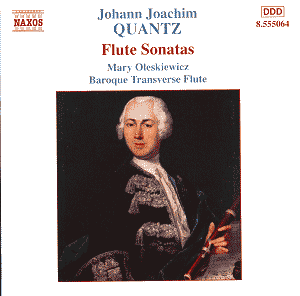Quantz, in his book published in Berlin in 1752,
‘On playing the Flute’ (Faber 1966 translated by Edward Reilly)
not only comments on the technique necessary for the transverse
flute, and copiously on music theory, but also throws light on
his attitude to composing and the training of young musicians
in general. For example in his introduction he writes "He
who wishes to compose should have a lively mind and fiery spirit,
united with a soul capable of a tender feeling; a good mixture
without too much melancholy but with much imagination, inventiveness,
judgement and discernment. A good memory, a good eye and ear"
etc. Now I used to think of Quantz as yet another mediocre baroque
composer with yards and yards of semiquavers. However, on hearing
this CD, and on reading the composer’s words I, quite rightly,
you shout, now think differently. It seems to me that Quantz has
an intriguing and original style, which can be full of passion,
joy and feeling as well as virtuosity.
It was obviously necessary for such a book to
be written about this instrument as he further writes "It
is true that this instrument has become very common in the last
thirty or forty years especially in Germany".
The present works were not published until Quantz
had died but he had a market in mind. He could also promote the
enlightened attitude of his dedicatee and one time employer. His
book and sonatas carry the following superscription: ‘In deepest
humility, may I venture to dedicate the present pages to my Lord
Frederick, King of Prussia.’
The CD notes written by this wonderful flautist,
Mary Oleskiewicz herself, paraphrase Quantz’s own words about
the extraordinarily low pitch: the striking qualities of Quantz
flutes, the ideal tone of which is described as ‘full, thick,
round and masculine’. This reflects the vocal timbres of the
virtuoso opera singers favoured by eighteenth century Dresden
where Quantz worked. This is enabled also by the playing of a
reproduction of the kind of wooden flute which Quantz himself
owned and made. This is carefully explained in the booklet notes.
Although the booklet does not say so the lowest note of this instrument
is a good quality Bb below middle C. Indeed when I first heard
this disc I thought that somehow it was playing at the wrong speed.
Then I thought that I was hearing some kind of horn, before my
ears focused on the sound carefully. Now to the music itself.
Two works are accompanied by fortepiano: the
D major Sonata and the Eb Trio Sonata. No reason is offered for
this but stylistically they appear to be more classical than baroque.
The rest use a double manual harpsichord.
There is I feel one dull piece and that is, sadly,
the Trio sonata for two flutes in D a four-movement work, which
seems to just go through the motions. The other works are attractive
and often fascinating. Dating them is a problem but worth attempting
if one is discover Quantz’s development as a composer. The Eb
Trio Sonata, written in Dresden, uses a key most suitable to the
baroque instruments with its darker tones. The two G minor Sonatas
are lyrical and inventive. QV 1:116 opens with an aria-like movement
perhaps pointing towards the popular opera arias mentioned above.
It then falls into a strict double fugue in which the young composer
tried to impress his teachers and older colleagues. After that
there is a real recitative completely authentic … just without
words. The later Sonata in C QV 1:9 has an Handelian opening (did
Quantz meet Handel in Dresden in 1719 when he visited in that
year?) which leads into an allegro inspired by a popular
aria at the time from Hasse’s opera ‘Cleofide’; heard in Dresden
in 1731. Incidentally I should add that Quantz was not born in
1679 as the box indicates but in 1697. His early music can therefore
be dated in the 1720s not the early 1700s. Quantz was based in
Dresden from 1721.
There is much on this CD to appreciate. Certainly
all flute players should have it and to anyone with an interest
in baroque music it will be greatly enjoyed.
Gary Higginson
see also review
by Jonathan Woolf
